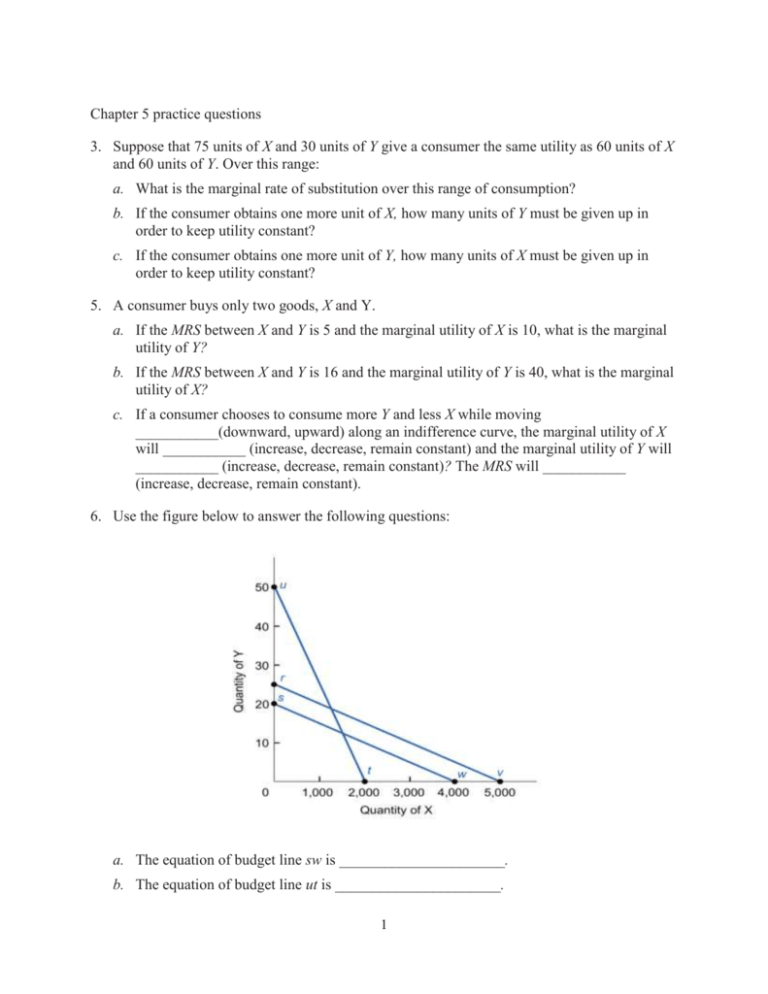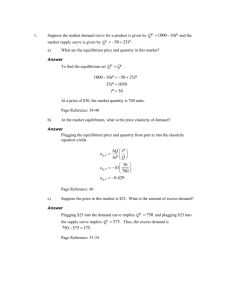Example questions (and answers) from class
advertisement

Chapter 5 practice questions 3. Suppose that 75 units of X and 30 units of Y give a consumer the same utility as 60 units of X and 60 units of Y. Over this range: a. What is the marginal rate of substitution over this range of consumption? b. If the consumer obtains one more unit of X, how many units of Y must be given up in order to keep utility constant? c. If the consumer obtains one more unit of Y, how many units of X must be given up in order to keep utility constant? 5. A consumer buys only two goods, X and Y. a. If the MRS between X and Y is 5 and the marginal utility of X is 10, what is the marginal utility of Y? b. If the MRS between X and Y is 16 and the marginal utility of Y is 40, what is the marginal utility of X? c. If a consumer chooses to consume more Y and less X while moving ___________(downward, upward) along an indifference curve, the marginal utility of X will ___________ (increase, decrease, remain constant) and the marginal utility of Y will ___________ (increase, decrease, remain constant)? The MRS will ___________ (increase, decrease, remain constant). 6. Use the figure below to answer the following questions: a. The equation of budget line sw is ______________________. b. The equation of budget line ut is ______________________. 1 c. The equation of budget line rv is ______________________. d. The equation of budget line uw is ______________________. e. If the relevant budget line is rv and the consumer’s income is $6,000, what are the prices of X and Y? At the same income, if the budget line is sw, what are the prices of X and Y? f. If the budget line is uw, P = $12.50 and P = $1,000, what is income? x y 7. Suppose a consumer has the indifference map shown below. The relevant budget line is LZ. The price of good Y is $200. a. What is the consumer’s income? b. What is the price of X? c. Write the equation for the budget line LZ. d. What combination of X and Y will the consumer choose? Why? e. What is the marginal rate of substitution at this combination? f. Explain in terms of the MRS why the consumer would not choose combinations designated by A or B. g. Suppose the budget line pivots to LM, income remaining constant. What is the new price of X? What combination of X and Y is now chosen? h. What is the new MRS? 11. Assume that an individual consumes three goods, X, Y, and Z. The marginal utility (assumed measurable) of each good is independent of the rate of consumption of other goods. The prices of X, Y, and Z are, respectively, $8, $9, and $10. The total income of the consumer is 2 $144, and the marginal utility schedule is as follows: Units of good Marginal utility of X Marginal utility of Y Marginal utility of Z 1 50 36 120 2 45 33 100 3 40 30 80 4 35 27 60 5 30 24 40 6 24 21 30 7 20 18 25 8 8 15 20 9 5 12 15 10 2 9 10 a. Given a $144 income, how much of each good should the consumer purchase to maximize utility? b. Suppose income rises to $254 with the same set of prices; what combination will the consumer choose? c. Let income fall to $30 and prices remain the same. How does the consumer allocate income now? d. Given the solution in part c, what would you say if the consumer maintained that X and Y are not purchased because she could no longer afford to buy X or Y? 3 Answers 3. a. MRS = 2 = - æ +30 ö DY = -ç DX è -15 ÷ø b. Utility remains constant if the consumer gives up 2 units of Y after obtaining 1 more unit of X éë -(DY / DX ) = -(-2 / +1) = 2ùû . c. Utility remains constant if the consumer gives up 1/2 unit of X after obtaining 1 more unit of Y éë -(DY / DX ) = -(+1/ -1 2) = 2ùû . 5. a. MRS = MUx/MUy , thus 10/MUy = 5 and MUy must be equal to 2. b. MRS = MUx/MUy , thus MUx/40 = 16 and MUx must be equal to 640. c. upward; increase; decrease; increase 6. a. sw: Y = 20 – 0.005X b. ut: Y = 50 – 0.0250X c. rv: Y = 25 – 0.005X d. uw: Y = 50 – 0.0125X e. Use the Y- and X-intercepts of budget line rv, 25 and 5,000, respectively, to find the prices of X and Y. Find the price of X: $6,000/ Px = 5,000 Px = $1.20. Find the price of Y: $6,000/ Py = 25 Py = $240. Similarly, for budget line sw, when income is $6,000: Find the price of X: $6,000/ Px = 4,000 Px = $1.50. Find the price of Y: $6,000/ Py = 20 Py = $300. f. Use the X- and Y-intercepts of budget line uw, 4,000 and 50, respectively, along with the given prices of X and Y ($12.50 and $1,000, respectively) to find the income associated with budget line uw (use either one of the following two equivalent solutions for income): M/$12.50 = 4,000 M = $50,000 M/$1,000 = 50 M = $50,000 7. a. $100,000 (= 500 $200) b. 400 Px = $100,000 Px = $250 c. For LZ: Y = 500 – 1.25X or 250X + 200Y = 100,000 d. The consumer will choose 200 units of X and 250 units of Y, where indifference curve II is tangent to budget line LZ. No other combination costing $100,000 provides more utility than X = 200 , Y = 250; i.e., no other bundle on LZ lies on a higher indifference 4 curve than indifference curve II. e. At the optimal choice, MRS = Px /Py = $250/$200 = 1.25. f. At combination A: The consumer could trade (give up) MRS units of Y to get 1 more unit of X and the consumer’s utility would be unchanged. The consumer must give up Px /Py units of Y to get 1 more unit of X and remain on the budget line. By visual inspection of slopes, MRS > Px /Py at combination A. Thus the consumer can buy 1 more X and give up only Px /Py units of Y, which is less than the loss of Y that would leave utility unchanged (i.e., MRS units of Y). Since the consumer gives up less Y than the amount that would leave the consumer indifferent, trading Px /Py units of Y for 1 more X must increase utility, and combination A would not be chosen by the consumer. At combination B: By the definition of MRS, the consumer can give up 1 unit of X in return for MRS more units of Y and the consumer’s utility will not change. With market prices Px and Py, the consumer can buy Px /Py (= 1.25) more units of Y if 1 less unit of X is purchased and remain on the budget line. Visual inspection of the slopes of the indifference curve and budget line at point B shows that Px /Py. MRS at combination B. The consumer can buy Px /Py more Y if 1 fewer unit of X is purchased, which is more Y than would be needed to remain indifferent. Therefore, giving up 1 unit of X to get MRS more units of Y must increase utility, and combination B would not be chosen by the consumer. g. 250 Px = $100,000; thus Px = $400. The consumer will now choose 300 units of Y and 100 units of X, where indifference curve I is tangent to budget line LM. h. MRS = Px /Py = $400/$200 = 2 11. a. 6 X, 4 Y, 6 Z b. 8 X, 10 Y, 10 Z c. 0 X, 0 Y, 3 Z. d. Since the price of X and the price of Y are both less than $30, the consumer can indeed afford to buy some of both good X and good Y. The consumer chooses not to purchase X or Y because MUx /Px and MUy /Py are both smaller than MUz /Pz when the consumer optimally allocates her $30 of spending. 5







